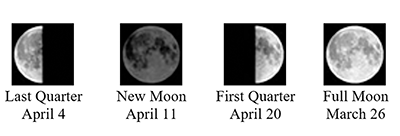Oddities of Orbits and Distance Can Help Connect Us to Our World
 By Scott Levine
By Scott Levine
Here’s a question: How far is Earth from the sun?
Back in the dark corners of your memory, behind the list of all the state capitals and the seven times table, you probably remember what you learned in grade school – about 93 million miles.
Like most things, the truth isn’t quite so simple. In 1609, the German super-genius Johannes Kepler brought the world the first of his three laws of planetary motion. It says that the planets all travel in elliptical – not circular – orbits. This puts the sun off-center, and means that orbits are stretched out, and slightly egg-shaped.
I don’t much care for the terms, myself, but when you hear the words “supermoon” and “micromoon” from time to time, it’s an example of Kepler’s first law. Only, it’s the moon’s egg-shaped orbit, and Earth is what’s off to one side.
In a circular orbit, every point along the path is the same distance from the sun. Every day, the sun would be 93 million miles away. With an ellipse, from one moment to the next we’re a different distance away; some closer, some farther.
 Earth’s aphelion, its most distant point, is about 94.5 million miles and happens in July. From there, we swing closer and closer until we reach our 91.5-million-mile perihelion in January. As Earth moves between those, there are two points where Earth is at that grade-school average distance: exactly 92.96 million miles away.
Earth’s aphelion, its most distant point, is about 94.5 million miles and happens in July. From there, we swing closer and closer until we reach our 91.5-million-mile perihelion in January. As Earth moves between those, there are two points where Earth is at that grade-school average distance: exactly 92.96 million miles away.
Astronomers call the average distance an astronomical unit (AU). It’s a handy way to measure distances to things that are, on the immense scale of the universe, nearby. It fits a nice gap between miles or kilometers, which are easy for measuring things about as far away as the moon or the solar system’s closest planets, and the distances to the farthest things from us.
Rather than saying Neptune is three billion miles away, we can say it’s 30 AU. It seems a little more manageable that way. On the other hand, we wouldn’t say the Andromeda Galaxy, the nearest big galaxy to our own, is 158,102,690,000 AU away. We don’t even bother with miles for things that far.
If you’re a fan of orbital geometry, this week’s for you. On Saturday, Apr. 3, we reach that magical 1-AU point. Then, through the summer, and clear out until October’s 1-AU day, you can say the distance from Earth to the sun is farther than the distance from the Earth to the sun. Trust me, no one will look at you funny.
It probably seems like just a trivial peculiarity, but maybe not. It’s fun to try to imagine all this as if you’re watching from some incredible distance away. Maybe you can think of all the planets looping around the sun, with their moons swirling around them, too.
As you pull your imagination out even farther, you can see our solar system traveling around the center of the Milky Way galaxy, making a complete orbit every 230 million years.
Things like these don’t directly affect our lives, but the way they can connect us to the world around us is incredible. I hope you have happy holidays, and your skies are clear tonight.
Scott Levine (astroscott@yahoo.com) is an astronomy writer and speaker from Croton-on-Hudson. He is also a member of the Westchester Amateur Astronomers, dedicated to astronomy outreach in our area. For information about the club, including membership, newsletters, upcoming meetings and lectures at Pace University and star parties at Ward Pound Ridge Reservation, visit westchesterastronomers.org. Star parties are free and open to the public but attendance is currently capped at 50 people, as required by New York State COVID-19 requirements.

Examiner Media – Keeping you informed with professionally-reported local news, features, and sports coverage.

 By Scott Levine
By Scott Levine